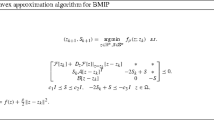Abstract
The optimum regulation problem of a bilinear system with a quadratic performance criterion is obtained in terms of a sequence of algebraic Lyapunov equations. The results are based on the method of successive approximations. The proof of convergence of the proposed scheme is given and the design procedure is illustrated by two examples.
Similar content being viewed by others
References
Mohler, R. R.,Natural Bilinear Control Processes, Academic Press, New York, New York, 1973.
Mohler, R. R.,Nonlinear Systems: Applications to Bilinear Control, Prentice-Hall, Englewood Cliffs, New Jersey, 1991.
Mohler, R. R.,Natural Bilinear Control Processes, IEEE Transactions on Systems Science and Cybernetics, Vol. 6, pp. 192–197, 1970.
Bruni, C., DiPillo, G., andKoch, G.,Bilinear Systems: An Appealing Class of Nearly-Linear Systems in Theory and Applications, IEEE Transactions on Automatic Control, Vol. 19, pp. 334–348, 1974.
Benallou, A., Mellichamp, D. A., andSeborg, D. E.,Optimal Stabilizing Controllers for Bilinear Systems, International Journal of Control, Vol. 48, pp. 1487–1501, 1988.
Cebuhar, W. A., andCostanza, V.,Approximation Procedures for the Optimal Control of Bilinear Systems, Journal of Optimization Theory and Applications, Vol. 57, pp. 411–427, 1988.
Ying, Y., Rao, M., andShen, X.,Bilinear Decoupling Control of Large-Scale Systems, Proceedings of the American Control Conference, Chicago, Illinois, pp. 1163–1167, 1992.
Gajic, Z., andShen, X.,Parallel Algorithms for Optimal Control of Large-Scale Systems, Springer Verlag, London, England, 1993.
Jacobson, D.,Extensions of Linear-Quadratic Control Systems, Springer Verlag, Berlin, Germany, 1980.
Bruni, C., Dipillo, G., andKoch, G.,On the Mathematical Models of Bilinear Systems, Ricerche di Automatica, Vol. 2, pp. 11–26, 1971.
Bittanti, S., Laub, A., andWillems, J., Editors,The Riccati Equation, Springer Verlag, Berlin, Germany, 1991.
Bellman, R. E.,Dynamic Programming, Princeton University Press, Princeton, New Jersey, 1957.
Bellman, R. E.,Adaptive Control Processes: A Guided Tour, Princeton University Press, Princeton, New Jersey, 1961.
Bellman, R. E.,Monotone Approximation in Dynamic Programming and Calculus of Variations, Proceedings of the National Academy of Science, Vol. 44, pp. 1073–1075, 1954.
Larson, R.,A Survey of Dynamic Programming Computational Procedures, IEEE Transactions on Automatic Control, Vol. 12, pp. 767–774, 1967.
Vaisbord, E.,An Approximate Method for the Synthesis of Optimal Control, Automation and Remote Control, Vol. 24, pp. 1626–1632, 1963.
Kleinman, D.,On Iterative Techniques for Riccati Equation Computations, IEEE Transactions on Automatic Control, Vol. 13, pp. 114–115, 1968.
Levine, M., andVilis, T.,On-Line Learning Optimal Control Using Successive Approximation Techniques, IEEE Transactions on Automatic Control, Vol. 19, pp. 279–284, 1973.
Mageriou, E.,Iterative Techniques for Riccati Game Equations, Journal of Optimization Theory and Applications, Vol. 22, pp. 51–61, 1977.
Leake, R., andLiu, R. W.,Construction of Suboptimal Control Sequences, SIAM Journal on Control, Vol. 5, pp. 54–63, 1967.
Milshtein, G.,Successive Approximation for Solution of an Optimum Problem, Automation and Remote Control, Vol. 25, pp. 298–306, 1964.
Kleinman, D.,An Easy Way to Stabilize a Linear Constant System, IEEE Transactions on Automatic Control, Vol. 15, p. 692, 1970.
Kirk, D.,Optimal Control Theory, Prentice-Hall, Englewood Cliffs, New Jersey, 1970.
Teo, K., Goh, C., andWong, K.,A Unified Computational Approach to Optimal Control Problems, Longman, New York, New York, 1991.
Aganovic, Z.,Optimal Reduced-Order Control of Singularly Perturbed and Weakly Coupled Bilinear Systems, Doctoral Dissertation, Rutgers University, 1993.
Kantorovich, L., andAkilov, G.,Functional Analysis in Normed Spaces, Macmillan, New York, New York, 1964.
Author information
Authors and Affiliations
Additional information
Communicated by T. L. Vincent
Rights and permissions
About this article
Cite this article
Aganovic, Z., Gajic, Z. Successive approximation procedure for steady-state optimal control of bilinear systems. J Optim Theory Appl 84, 273–291 (1995). https://doi.org/10.1007/BF02192115
Issue Date:
DOI: https://doi.org/10.1007/BF02192115



